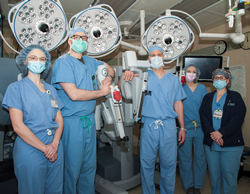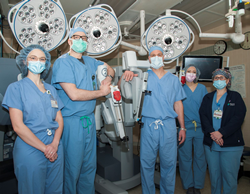
AGH’s surgical team performs novel procedure. From left to right: Shannon Masterson, PA-C; Daniel Murariu, MD, MPH, MBA, FACS; Richard Fortunato, DO, FACS, FASCRS; Cara Carano, RN; Lauren Smith, RN
“Very few surgical programs in the country have developed the expertise to perform reconstructive surgery with the da Vinci system, and the application of this technique is already extending beyond breast and colorectal procedures,” said Dr. Murariu.
PITTSBURGH (PRWEB)
April 19, 2021
Plastic surgeons at Allegheny General Hospital (AGH), the flagship academic medical center of Allegheny Health Network (AHN), are now among the first in the region to perform innovative breast and colorectal reconstruction procedures utilizing the da Vinci Xi surgical system. The minimally-invasive, robot-assisted technology is the latest advancement in the field of reconstructive procedures aimed at rebuilding areas of the body often affected by aggressive cancer therapies.
The majority of patients in need of specialized reconstruction surgeries are either currently undergoing cancer treatment or are cancer survivors who have previously undergone significant chemotherapy, radiation and/or surgical treatments. For example, more than 100,000 women each year undergo mastectomy procedures to treat or prevent breast cancer, and the removal of the breast tissue often leaves many to consider subsequent surgeries such as breast reconstruction. For colorectal cancer, a colectomy – or removal of part or the entire colon – may be prescribed as a similar course of treatment.
Daniel Murariu, MD, FACS, director of Microsurgery and Lymphatic Surgery at AHN, is the first plastic surgeon in the region to offer the reconstruction procedures using the robot. Most recently, alongside Richard Fortunato, DO, FACS, colon and rectal surgeon, who performed the oncologic resection, Dr. Murariu reconstructed the perineal area with the rectus abdominis muscle which included a skin paddle, a first using the robot.
Using the da Vinci Xi surgical system, which includes robot-assisted technology, Dr. Murariu targets the precise incision point that was utilized to remove cancerous tissue, and in some instances, creates only one or two additional minor incisions. Through the sole entry point, the appropriate muscle tissue is taken from the abdomen and used to rebuild the portions of the breast or colon and rectum.
“This minimally-invasive procedure virtually eliminates the need to make big cuts into a patient’s abdomen or back to utilize tissue that can be used for the reconstruction. The ability to use robotic technology allows us to centralize any discomfort to an incision that is often less than .8 centimeters long,” explained Dr. Murariu. “It’s an exciting advancement in the field of plastic surgery as it minimizes patient discomfort, lessens the risk of surgical complications and alleviates an intensive recovery process.”
Traditionally, breast reconstruction has been performed through an open approach, either implant-based or an autologous tissue flap. In a 2020 study published in Plastic and Reconstructive Surgery (“Robotic Surgery: A Novel Approach for Breast Surgery Reconstruction” doi: 10.1097/GOX.0000000000002578), plastic surgeons from the University College London reported robot-assisted surgery is superior to the laparoscopic technique with improved three-dimensional visualization, dexterity and range of motion to guide around the curvature of the breast. The study noted a reduction of scar length, shorter hospital stays and lower complication rates with robotic surgery compared to the traditional open flap procedure.
Widely recognized as a pioneering technology in the field of laparoscopic and minimally-invasive surgery, the da Vinci Xi robot is used across many disciplines including cardiovascular surgery, neurosurgery, urology, gynecology and more. AHN surgeons have been leaders in the development and utilization of the da Vinci system across these various specialties over the past two decades.
“Very few surgical programs in the country have developed the expertise to perform reconstructive surgery with the da Vinci system, and the application of this technique is already extending beyond breast and colorectal procedures,” continued Dr. Murariu. “We’ve also used the method for perineal hernias and vaginal reconstruction, and we look forward to bringing even more innovative applications for the technology in the near future for head and neck reconstruction which will improve the overall surgical experience and recovery of patients, especially cancer survivors.”
AHN patients who undergo reconstructive procedures as a result of cancer treatments are cared for by a compassionate, multidisciplinary team of oncologists and other caregivers from the AHN Cancer Institute. Clinicians from various cancer disciplines, including medical, surgical and radiation oncology, work together closely to determine the most effective course of treatment to meet a patients’ long-term health goals and needs.
For more information on the AHN Cancer Institute or to learn more about the AHN Plastic Surgery division, visit ahn.org.
###
About Allegheny Health Network
Allegheny Health Network (AHN.org) a Highmark Health company, is an integrated healthcare delivery system serving the greater Western Pennsylvania region. The Network is composed of 13 hospitals, ambulatory surgery centers, Health + Wellness Pavilions, an employed physician organization, home and community based health services, a research institute and a group purchasing organization. The Network provides patients with access to a complete spectrum of advanced medical services, including nationally recognized programs for primary and emergency care, cardiovascular disease, cancer care, orthopedic surgery, neurology and neurosurgery, women’s health, diabetes and more. AHN employs approximately 21,000 people, has more than 2,600 physicians on its medical staff and serves as a clinical campus for Drexel University College of Medicine and the Lake Erie College of Osteopathic Medicine.
Share article on social media or email:

